Aces High Air Manuals
Volume 21: British & Commonwealth Jets - Cold War
Supermarine Attacker
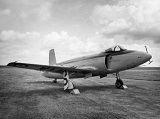
|
Supermarine Attacker F1, FB1 & FB2 Pilot's Notes
71 pages
The Supermarine Attacker was a British single-seat naval jet fighter built by Supermarine for the Royal Navy's Fleet Air Arm (FAA). The type has the distinction of being the first jet fighter to enter operational service with the FAA. Like most other first-generation jet fighters, it had a short service life due to the rapid development of increasingly advanced aircraft during the 1950s and 1960s.
|
Blackburn Buccaneer
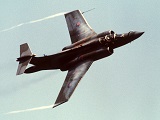
|
Blackburn Buccaneer S. Mk.1 Aircrew Notes
292 pages
The Blackburn Buccaneer was a Royal Navy (RN) carrier-borne attack aircraft designed in the 1950s. Designed and initially produced by Blackburn Aircraft at Brough, it was later officially known as the Hawker Siddeley Buccaneer when Blackburn became a part of the Hawker Siddeley group, but this name was rarely used.
The Buccaneer was originally designed in response to the Soviet Union's massive Sverdlov-class cruiser construction program. Instead of building a new fleet of their own, the Buccaneer would attack these ships with relative impunity by approaching at low altitudes below the ship's radar horizon. The Buccaneer would attack using a nuclear bomb or conventional weapons in engagements lasting less than a minute, quickly flying out of range while its weapons struck. It was later intended to carry short-range anti-shipping missiles to further enhance its survivability against more modern ship-based anti-aircraft weapons. The Buccaneer entered RN service in 1962. |

|
Blackburn Buccaneer S. Mk.2 Aircrew Notes
349 pages
The RN retired the last of its large aircraft carriers in 1978, moving their strike role to the British Aerospace Sea Harrier and passing their Buccaneers to the RAF. After a crash in 1980 revealed metal fatigue problems, the RAF fleet was reduced to 60 aircraft, while the rest of the fleet was scrapped. The ending of the Cold War led to a drawdown of the RAF and the accelerated retirement of the remaining fleet, with the last Buccaneers in RAF service being retired in 1994 in favour of the Panavia Tornado. The South African Air Force also procured the type. Buccaneers saw combat action in the Gulf War and the South African Border War.
|
Avro Canada Canuck

|
Avro Canada CF-100 Canuck Aircraft Operating Instructions
152 pages
The Avro Canada CF-100 Canuck (affectionately known as the "Clunk") was a Canadian jet interceptor/fighter serving during the Cold War both in NATO bases in Europe and as part of NORAD. The CF-100 was the only Canadian-designed fighter to enter mass production, serving primarily with the RCAF/CAF and in small numbers in Belgium. For its day, the CF-100 featured a short takeoff run and high climb rate, making it well suited to its role as an interceptor.
|
Folland Gnat
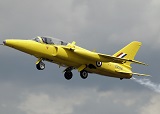
|
Folland Gnat Mk. 1 (Finnish Air Force) Pilot's Notes
141 pages
The Folland Gnat is a small, swept-wing British subsonic jet trainer and light fighter aircraft developed by Folland Aircraft for the Royal Air Force.
|

|
Folland Gnat T. Mk. 1 Operating Data Manual
87 pages
The Gnat was designed by W.E.W. Petter as a development of the private venture Folland Midge. It first flew in 1955. Its design allowed its construction without specialised tools by countries not highly industrialised. Although never used as a fighter by the Royal Air Force (RAF), the Gnat T.1 trainer variant was widely used. The Gnat became well known as the aircraft of the RAF's Red Arrows aerobatic team.
The Gnat was exported to Finland, Yugoslavia and India. The Indian Air Force became the largest operator and eventually manufactured the aircraft under licence. India then developed the HAL Ajeet, a modified and improved variant. |
Hawker Hunter

|
Hawker Hunter F.1 Pilot's Notes
58 pages
The Hawker Hunter is a transonic British jet aircraft developed in the late 1940s and early 1950s. The single-seat Hunter entered service as a manoeuvrable fighter aircraft, and later operated in fighter-bomber and reconnaissance roles in numerous conflicts. Two-seat variants remained in use for training and secondary roles with the Royal Air Force (RAF) and Royal Navy until the early 1990s. The Hunter was also widely exported, serving with 21 other air forces. Sixty years after its original introduction it was still in active service, operated by the Lebanese Air Force until 2014.
|

|
Hawker Hunter F.2 Pilot's Notes
44 pages
On 7 September 1953, the modified first prototype broke the world air speed record for jet-powered aircraft, achieving 632.29 kn. Hunters were also used by two RAF display teams: the "Black Arrows", who on one occasion looped a record-breaking 24 examples in formation, and later the "Blue Diamonds", who flew 16 aircraft.
|

|
Hawker Hunter F.4 Pilot's Notes
73 pages
Overall, 1,972 Hunters were produced by Hawker Siddeley and under licence. In British service, the aircraft was replaced by the English Electric Lightning, the Hawker Siddeley Harrier and the McDonnell Douglas F-4 Phantom II.
|

|
Hawker Hunter F Mk.6 Pilot's Notes
172 pages
Hunters were flown by No.63, No. 234 and No. 79 Squadrons acting in training roles for foreign and Commonwealth students. These remained in service until after the Hawk T.1 entered service in the mid-1970s.
|
Gloster Javelin
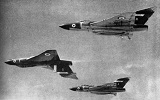
|
Gloster Javelin F.(A.W.) Mk.1 Pilot's Notes
64 pages
The Gloster Javelin was a twin-engined T-tailed delta-wing subsonic night and all-weather interceptor aircraft that served with Britain's Royal Air Force from the mid-1950s and until the late 1960s. The last aircraft design to bear the Gloster name, it was introduced in 1956 after a lengthy development period and received several upgrades during its lifetime to its engines, radar and weapons, including support for the De Havilland Firestreak air-to-air missile.
|

|
Gloster Javelin F.(A.W.) Mk.7 Pilot's Notes
65 pages
The Javelin was succeeded in the interceptor role by the English Electric Lightning, a supersonic aircraft capable of flying at more than double the Javelin's top speed, which was introduced into the RAF only a few years later. The Javelin served for much of its life alongside the Lightning; the last Javelins were withdrawn from operational service in 1968 following the introduction of successively more capable versions of the Lightning.
|
English Electric Lightning

|
English Electric Lightning F. Mk I & F. MkIA Pilot's Notes
220 pages
The English Electric Lightning is a supersonic fighter aircraft of the Cold War era. It was designed, developed, and manufactured by English Electric, which was subsequently absorbed by the newly formed British Aircraft Corporation. It was then marketed as the BAC Lightning. The Lightning was the only all-British Mach 2 fighter aircraft. The Lightning was used by the Royal Air Force (RAF) and the Royal Saudi Air Force (RSAF). Although it was the RAF's primary interceptor for more than two decades it was never required to attack another aircraft.
The Lightning is powered by two Rolls-Royce Avon turbojet engines in a unique staggered stacked installation in the fuselage. The Lightning was developed to intercept increasingly capable bomber aircraft (Tupolev Tu-16, Tupolev Tu-22, Tupolev Tu-95), and thus has exceptional rate of climb, ceiling, and speed; pilots have described flying it as "being saddled to a skyrocket". This performance made the Lightning a 'fuel critical' aircraft meaning that its missions are dictated to a high degree by its limited range. Later developments provided greater range and speed along with aerial reconnaissance and ground-attack capability. |
Gloster Meteor
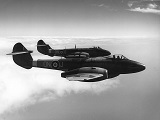
|
Gloster Meteor III Pilot's Notes
23 pages
The Gloster Meteor was the first British jet fighter and the Allies' only operational jet aircraft during the Second World War. The Meteor's development was heavily reliant on its ground-breaking turbojet engines, pioneered by Sir Frank Whittle and his company, Power Jets Ltd. Development of the aircraft itself began in 1940, although work on the engines had been under way since 1936. The Meteor first flew in 1943 and commenced operations on 27 July 1944 with No. 616 Squadron RAF. Nicknamed the "Meatbox", the Meteor was not a sophisticated aircraft in its aerodynamics, but proved to be a successful combat fighter. Gloster's 1946 civil Meteor F.4 demonstrator G-AIDC was the first civilian-registered jet aircraft in the world.
|

|
Gloster Meteor 4 Pilot's Notes
35 pages
Several major variants of the Meteor incorporated technological advances during the 1940s and 1950s. Thousands of Meteors were built to fly with the RAF and other air forces and remained in use for several decades. The Meteor saw limited action in the Second World War. Meteors of the Royal Australian Air Force (RAAF) fought in the Korean War. Several other operators such as Argentina, Egypt and Israel flew Meteors in later regional conflicts. Specialised variants of the Meteor were developed for use in photographic aerial reconnaissance and as night fighters.
|

|
Gloster Meteor F.8 and F.R.9 Pilot's Notes
49 pages
The Meteor was also used for research and development purposes and to break several aviation records. On 7 November 1945, the first official air speed record by a jet aircraft was set by a Meteor F.3 of 606 miles per hour. In 1946, this record was broken when a Meteor F.4 reached a speed of 616 mph. Other performance-related records were broken in categories including flight time endurance, rate of climb, and speed. On 20 September 1945, a heavily modified Meteor I, powered by two Rolls-Royce Trent turbine engines driving propellers, became the first turboprop aircraft to fly. On 10 February 1954, a specially adapted Meteor F.8, the Meteor Prone Pilot, which placed the pilot into a prone position to counteract inertial forces, took its first flight.
|

|
Gloster Meteor Marks 11, 12, 13, and 14 Pilot's Notes
65 pages
In the 1950s, the Meteor became increasingly obsolete as more nations introduced jet fighters, many of these newcomers having adopted a swept wing instead of the Meteor's conventional straight wing; in RAF service, the Meteor was replaced by newer types such as the Hawker Hunter and Gloster Javelin. As of 2013, two Meteors, WL419 and WA638, remain in active service with the Martin-Baker company as ejection seat testbeds. Two further aircraft in the UK remain airworthy, as does another in Australia.
|
Supermarine Scimitar

|
Supermarine Scimitar F. Mk I Pilot's Notes
201 pages
The Supermarine Scimitar was a British naval fighter aircraft operated by the Royal Navy Fleet Air Arm. The prototype for the eventual production version flew in January 1956 and production aircraft were delivered in 1957. It saw service with the Royal Navy from 1958 until 1969.
Photo credit: TSRL@wikipedia (CC-BY-SA 3.0) |

|
Supermarine Scimitar F. Mk I Operating Data
91 pages
The aircraft pioneered fuel flow proportioning and integral main-plane tanks, along with "blown" flying surfaces, to reduce landing speeds. At one time, it held the record of 1,000 maintenance hours per flying hour.[citation needed] Although the Scimitar could operate as a fighter, the interceptor role was covered by the de Havilland Sea Vixen. In the attack role it was replaced by the Blackburn Buccaneer. The Scimitar was retained initially as a tanker to allow the underpowered Buccaneer S.1 to be launched from aircraft carriers with a useful weapons load. To save weight, the Buccaneer would take off with minimum fuel then top up from a Scimitar.
Photo credit: TSRL@wikipedia (CC-BY-SA 3.0) |
Hawker Sea Hawk
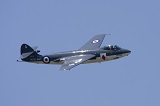
|
Hawker Sea Hawk F.1 Pilot's Notes
41 pages
The Hawker Sea Hawk was a British single-seat jet fighter of the Fleet Air Arm (FAA), the air branch of the Royal Navy (RN), built by Hawker Aircraft and its sister company, Armstrong Whitworth Aircraft. Although its origins stemmed from earlier Hawker piston-engined fighters, the Sea Hawk became the company's first jet aircraft.
Following the type's acceptance in the RN, the Sea Hawk proved to be a reliable and sturdy workhorse. A considerable number were also produced for the export market, and were operated from aircraft carriers in both Dutch and Indian service. The last operational Sea Hawks, operated by the Indian Navy, were retired in 1983. Photo credit: Smudge 9000@wikipedia (CC-BY 2.0) |
De Havilland Sea Vixen
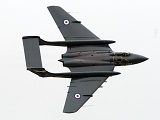
|
De Havilland Sea Vixen FAW (Fighter All Weather) Mk.2 Pilot's Notes
149 pages
The de Havilland DH.110 Sea Vixen is a twin boom, twin-engined 1950s–60s British two-seat jet fighter of the Fleet Air Arm designed by de Havilland at Hatfield, Hertfordshire. Developed from an earlier first generation jet fighter, the Sea Vixen was a capable carrier-based fleet defence fighter that served into the 1970s. Initially produced by de Havilland, it was later known as the Hawker Siddeley Sea Vixen after de Havilland became a part of the Hawker Siddeley Group in 1960. A single example remains airworthy today in the UK and is displayed regularly at airshows.
Photo credit: Cobatfor@wikipedia (CC-BY-SA 3.0) |
Supermarine Swift

|
Supermarine Swift F.1 and F.2 Pilot's Notes
46 pages
The Supermarine Swift was a British single-seat jet fighter of the Royal Air Force (RAF), built by Supermarine during the 1950s. After a protracted development period, the Swift entered service as an interceptor, but, due to a spate of accidents, its service life was short. A photo reconnaissance variant resolved some of the Swift's teething problems.
|
De Havilland Vampire and Sea Vampire
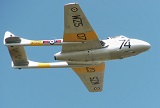
|
De Havilland Vampire F1 Pilot's Notes
23 pages
The de Havilland Vampire is a British jet fighter developed and manufactured by de Havilland. Having been developed during the Second World War to harness the newly developed jet engine, the Vampire entered service with the Royal Air Force (RAF) in 1945. It was the second jet fighter, after the Gloster Meteor, operated by the RAF, and its first to be powered by a single jet engine.
|

|
De Havilland Vampire Mks. 4, 6, 20, 50, 52 Pilot's Flight Manual
93 pages
The RAF used the Vampire as a front-line fighter until 1953, when it was given secondary roles such as pilot training, although 103 Flying Refresher School had them deployed in that role from 1951. It was retired by the RAF in 1966, replaced by the Hawker Hunter and Gloster Javelin. It achieved several aviation firsts and records, including being the first jet aircraft to cross the Atlantic Ocean. The Vampire had many export sales and was operated by various air forces. It participated in conflicts including the 1948 Arab–Israeli War, the Malayan emergency and the Rhodesian Bush War.
|

|
De Havilland Vampire FB5 & FB9 Pilot's Notes
42 pages
Almost 3,300 Vampires were manufactured, a quarter of them built under licence in other countries. The Royal Navy's first jet fighter was the Sea Vampire, a navalised variant which was operated from its aircraft carriers. The Vampire was developed into the DH.115 dual-seat trainer and the more advanced DH.112 Venom ground-attack and night fighter.
|

|
De Havilland/English Electric Sea Vampire F.20 Pilot's Notes
56 pages
The Sea Vampire F.20 is a naval version of the Vampire FB.5. 18 aircraft were built by English Electric. De Havilland built 73 Sea Vampire F.22s.
|
De Havilland Venom and Sea Venom
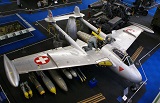
|
De Havilland Venom F.B.4 Pilot's Notes
53 pages
The de Havilland DH 112 Venom was a British postwar single-engined jet aircraft developed from the de Havilland Vampire. It served with the Royal Air Force as a single-seat fighter-bomber and two-seat night fighter. The Venom was an interim between the first generation of British jet fighters – straight-wing aircraft powered by centrifugal flow engines such as the Gloster Meteor and the Vampire and later swept wing, axial flow-engined designs such as the Hawker Hunter and de Havilland Sea Vixen. The Venom was successfully exported, and saw service with Iraq, New Zealand, Sweden, Switzerland and Venezuela.
|
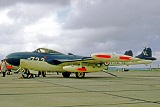
|
De Havilland Sea Venom F.A.W. 20 Pilot's Notes
91 pages
The de Havilland Sea Venom was a British postwar carrier-capable jet aircraft developed from the de Havilland Venom. It served with the Royal Navy Fleet Air Arm and with the Royal Australian Navy. The French Navy operated the Aquilon, a version of the Sea Venom FAW.20 licence-built by SNCASE (Sud-Est).
Photo credit: RuthAS@wikipedia (CC-BY 3.0) |
